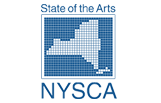

History of the Organization
Lake George Opera, now Opera Saratoga, began with a production of Die Fledermaus at the Diamond Point Theatre on July 5, 1962, playing to an audience of 230. The Company now calls Saratoga Springs home and performs for more than 25,000 people annually. To date, the Company has performed ninety different fully-staged works by fifty-two different composers, including thirty-three works by American composers and ten premiere productions. Throughout its history, the Company's continued success has been shaped by visionary leaders, talented artists, and critically acclaimed productions.
Visionary Fred Patrick, with his wife soprano Jeanette Scovotti, established the company in Lake George seeking a permanent seasonal repertory company that presented opera in English and showcased young, talented American singers. An ambitious first season included forty-six performances in eight weeks, fully-staged with two pianists providing accompaniment.
Growing audiences and performances with orchestra quickly followed, and in 1965, the Opera moved to the newly completed auditorium at the Queensbury High School in Glens Falls. That year also saw the formation of the Company's first Board of Directors and the loss, to cancer at just 37 years old, of Fred Patrick. Then current artistic director David Lloyd was appointed General Director, a post he held until 1980. During Lloyd's tenure, the Company gave its first contemporary and American operas, Menotti's The Telephone in 1965 and Robert Ward's The Crucible in 1966, and four world premiere productions: David Amram's Twelfth Night and Robert Baksa's Aria da Capo, both in 1968, The Child by Jose Bernardo in 1974, and Alva Henderson's The Last of the Mohicans in 1977. He formed the Contemporary American Opera Studio in 1980 and introduced Opera-on-the-Lake in 1972, a program which launches each summer season even today.
From 1981 through 1985, Paulette Haupt-Nolen served as Artistic Director, initiating collaborations with the Eugene O'Neill Theater Center to workshop new operas and Proctor's Theatre for a production of Man of La Mancha. She produced the Company's first opera at the Spa Little Theater in Saratoga Springs, the world premiere of The Adventures of Friar Tuck by Glenn Paxton, and introduced the traveling Opera-On-Wheels Program in 1985.
The late 1980's welcomed Artistic Directors Brian Lingham (1986-87) and John Balme (1988-91), inaugurated the Opera-to-Go education program in 1986, and saw the world premiere of Mark Houston's Hazel Kirke, an opera set in the Hudson River Valley in the 1840's. The 1989 and 1990 seasons were performed at Adirondack Community College, while the Queensbury High School Auditorium underwent renovations.
In 1991, Susan T. Danis was appointed to the newly-established post of Managing Director and the Company returned to Queensbury. 1993 was a transitional year, with David Lloyd returning as Interim Artistic Director, and the Opera featured many alumni in three gala concerts, performing no fully-staged productions.
Joseph Illick became Artistic Director for the next five summers, programming a variety of works that included Rossini's La Donna del Logo, Massenet's Cendrillon, Jorge Martin's Tobermory, Richard Wargo's The Music Shop, and Britten's A Midsummer Night's Dream, the latter featuring the Boys Choir of Harlem as the Spirits in the Forest.
1998 brought major changes for Lake George Opera. Due to renovations at the Queensbury High School, the Company performed its summer season in the Spa Little Theater on the grounds of Saratoga Spa State Park in Saratoga Springs. The 500-seat theater proved a perfect venue for intimate opera, and, though the move was initially intended to be temporary, it has remained the Company's main performance space since then. In 1998, the Company also began performing operas in their original languages with projected supertitles.
In 1999, the Company hired conductor Daniel Beckwith and stage director Marc Verzatt as Co-Artistic Directors. Shortly thereafter, William Florescu joined the company as Artistic Director. The new team established a brand of intimate opera theater that would characterize Lake George Opera productions going forward. Important projects during this period included notable productions of Ariadne auf Naxos in the Spa Little Theater, Madama Butterfly in partnership with the Saratoga Performing Arts Center in SPAC's outdoor amphitheater, and initiation in 2000 of a five-year Opera to Go education tour cycle of operas by John Davies.
In 2002, William Florescu assumed both executive and administrative leadership responsibilities. During the next three years, he re-introduced American operas into the repertory, showcased Apprentice Artists in concert programs with orchestra, initiated the Lake George Opera Summer Camp, and, along with event Chairs Ted and Carol Newlin, initiated the Company's annual Opera Ball.
In 2005, Florescu moved to the Florentine Opera in Milwaukee, and Curtis Tucker became the Company's eighth Artistic Director. In 2006, Tucker guided an expanded summer season that included the professional premiere of Ned Rorem's Our Town and a semi-staged Apprentice Artist performance of Menotti's The Medium. In 2007, the Company featured operas set in Paris, including a chestnut, La Bohème, an American opera, Kirke Mechem's Tartuffe, and a fully-staged Apprentice Artist feature, La Vie Parisienne. For 2008 the Company produced La Traviata, The Pirates of Penzance and Gianni Schicchi with Buoso's Ghost.
2009 saw the Company produce Madama Butterfly, Don Pasquale and the developmental premiere of Eleanor Roosevelt. In 2011, the Company celebrated its 50th season under its new name, Opera Saratoga. We hope you were able to join us in celebrating this milestone, and we look forward to another successful 50 years of professional opera in upstate New York!







